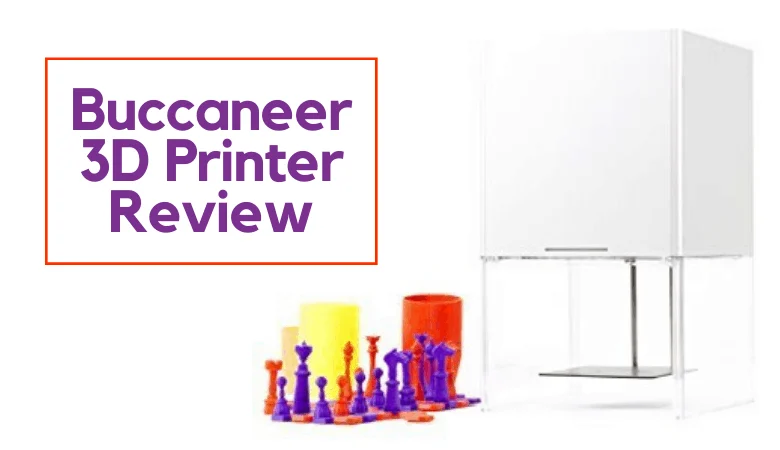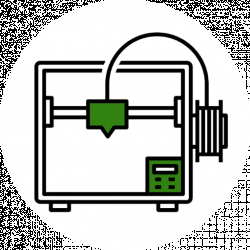- Creality Ender vs Anet A8 [2022]: Which is Better? - April 14, 2022
- TEVO Tornado Review [2022] All You Need To Know - April 6, 2022
- Anet A6 Review [2022 UPDATED Version] - April 5, 2022
Pirate 3D is among the many 3D printing companies that were made possible by the many enthusiastic users on Kickstarter.com. Their Kickstarter campaign began just a couple of years ago and since that time has raised over $1.4 million from over 3,500 different backers.
While many 3D printing companies have enjoyed success on Kickstarter, Pirate 3D’s statistics rank among some of the most successful campaigns ever in the 3D printer space.
The printer is called the Buccaneer and is designed for beginner to intermediate users that want an easy to use 3D printer without having to make a large investment. It is priced well below $1,000 which makes it affordable 3D Printer for intermediate 3D printing enthusiasts and beginners who are trying things out for the first time.
While many 3D printers have been brought to market in this very same way, results can vary quite a bit. Raising money for a great idea is one thing, actually manufacturing a quality printer and delivering on customer expectations is quite another. Now that the Buccaneer is actually out on the market, we decided to have a look for ourselves and see what this new budget-style 3D printer can offer.
Table of Contents
Design and Appearance of the Buccaneer
Design: The design of this printer is a bit of a mixed bag, as sometimes things look a bit better than they actually are. The printer does have a very nice look to it that is sleek, modern and smooth. It actually looks a little more upscale than some 3D printers that are considerably more money. However, once you get up close and personal with the unit you will realize that looks can be somewhat deceiving. The initial design plan for this printer was for the enclosure piece to be constructed from high-quality aluminum, but I guess this aspect of the design did not make it all the way to the factory floor.
Construction: On the finished product, the enclosure piece is constructed of polycarbonate and then molded around the unit’s frame. The frame appears to be solid and made of stamped steel, so no issue there. However, the polycarbonate is basically a cheap way out and really takes away from the structural integrity of the printer. In a couple of words, it feels and is cheap and unstable. It is a little surprising that the enclosure was not damaged during the shipping process. On a good note, I suppose, they did do a nice job of securely packaging the unit and it arrived without any damage at all.
Enclosure: Once you get past the actual construction of the enclosure piece, its appearance is nice and sports a brushed aluminum look. While many 3D printers come with the inner parts partially or fully exposed, not the Buccaneer. The enclosure fully wraps around the unit hiding all of the internal components. In fact, it would be hard for anyone to tell that it is a 3D printer at all without a much closer inspection. The sleek and modern appearance are by far one of the best design aspects of the printer as many budget style printers look just plain rough like you just pieced it together in your backyard.
Printer Bed: However, the upside of the printer’s appearance also has a downside, because it tends to not be very user-friendly when you are trying to perform printing operations. Since the printer bed is covered from view by the enclosure you are not able to see what is going on when printing functions first begin. With a printer that does not have a heated build plate, it is very important to make sure the foundation of your design begins properly. The Buccaneer makes that a bit tough to do in an easy way.
Features and Printing
- Poor Delivery on Features: Right upfront we should say that the planned specs and features of this printer changed quite a bit from what was originally listed on their initial Kickstarter campaign to what was finally actually offered on the production unit. On top of the enclosure change mentioned above, the printer was also supposed to include a heated build plate and have the capability of using both ABS and PLA. Unfortunately, those specs never made it onto the final model, which is disappointing. For a more thorough autopsy of what went wrong, check out this article.
- Price Point: If there is one area the Buccaneer excels in it is simplicity, which is a plus for a printer that is designed as a budget style unit intended for beginners. The setup process is painless and easy to accomplish. In fact, it is so simple you don’t even have to press a power button to get it started, simply plug the 3D printer into a power source and it powers up automatically. Of course, this means you have to remember to turn it off by unplugging the unit too.
- Ease of Use: There are no complicated controls to learn about on the printer itself, all functions are controlled through your computer once you connect it to the Buccaneer via Wi-Fi and utilize the system management software.
- Compatibility: The printer is compatible with Windows, Android and iOS devices but oddly does not play well with OS X systems. The whole wireless concept is nice in theory but in practice, it actually does not work very well. The connection utility seems to have a bug and can act very sporadic at times. Even more annoying, there is no option for using an SD card or USB cable as the Buccaneer has no available ports. So it is wireless or nothing.
- User Interface: The entire user interface is as basic as it gets, which is both good and bad. While the Wi-Fi connection utility is buggy, the system management software is not and seems to run smoothly.
- Resolutions: You can turn, rotate and change the size of designs in an efficient manner using the software and choose resolutions between fifty and three hundred twenty microns. The range of resolutions is fairly impressive given the price point of the printer.
- Print Speed: If you aren’t too hung up on quality and can live with the lower resolutions then the Buccaneer can bang out designs much quicker than we thought it would. Overall, the printing speed is above average taking all things into account.
- Print Quality: The printing quality is nothing to write home about and just okay, nothing too exciting and no major issues. However, one annoyance is due to the lack of a heated bed you must always use a raft as a base for each product you print. Of course, this adds time to printing projects and increases the amount of filament used.
- Calibration: The auto-calibration functions seemed to work perfectly and automatically adjusted before each project. Not having to mess with manually calibrating the build plate is a nice advantage on a budget printer.
Features – Summary
- 50-320 microns
- Build volume: 130 x 96 x 139 (millimeters)
- Filament: 1.75mm
- PLA Only
- No heated bed
- Nozzle: 0.4 mm
- Simple user interface
- Easy setup
- Fast 3D printing capability
Wrapping Up – Overall Recommendation
I was not overly impressed with the Buccaneer and actually not impressed at all. Anytime you promise high-quality specs upfront and then move to a cheaper design on the final product it is not a good sign.
The price is certainly right as it gives many 3D printing beginners a chance to own a 3D printer at a very low cost (see here for latest pricing).
However, with all of the various issues, bugs and quality problems, we think you can probably find a better overall value than the Buccaneer. If you have very low requirements for quality then it might be worth a look, but buyer beware on this one as it might be disappointing.
However, I’d recommend checking out our buying guide on the best 3D printers if want something better.



